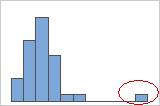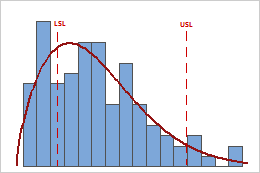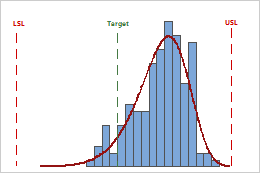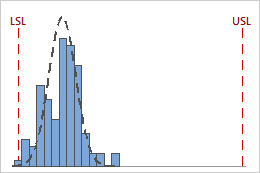In This Topic
Step 1: Check your data for problems

Outlier
Step 2: Examine the observed performance of your process
Use the capability histogram to examine the sample observations in relation to the process requirements.
Examine the process spread
Visually examine the data in the histogram in relation to the lower and upper specification limits. Ideally, the spread of the data is narrower than the specification spread, and all the data are inside the specification limits. Data that are outside the specification limits represent nonconforming items.

In this histogram, the process spread is wider than the specification spread, which suggests poor capability. Although most of the data are within the specification limits, many nonconforming items are below the lower specification limit (LSL) or above the upper specification limit (USL).
Note
To determine the actual number of nonconforming items in your process, use the results for PPM < LSL, PPM > USL, and PPM Total. For more information, go to All statistics and graphs.
Assess the location of the process
Evaluate whether the process is centered between the specification limits or at the target value, if you have one. The peak of the distribution curve shows where most of the data are located.

In this histogram, although the sample observations fall inside the specification limits, the peak of the distribution curve is not on the target. Most of the data exceed the target value and are located near the upper specification limit.
Step 3: Evaluate the capability of the process
For a parametric analysis, use Ppk to evaluate the overall capability of your process based on both the process location and the process spread. For a nonparametric analysis, use Cnpk to evaluate overall capability. Overall capability indicates the actual performance of your process that your customer experiences over time.
Generally, higher values of either statistic indicate a more capable process. Lower values indicate that your process may need improvement.
Compare statistics that measure overall capability to a benchmark value that represents the minimum value that is acceptable for your process. Many industries use a benchmark value of 1.33. If the statistic is lower than your benchmark, consider ways to improve your process.

Key Result: Ppk
For these process data, Ppk = 0.25. Because Ppk is less than 1.33, the overall capability of the process does not meet customer requirements.
Assess potential capability for data that follow a normal distribution
You can assess potential capability for normal data or for data that follow a normal distribution after transformation. Use Cpk to evaluate the potential capability of your process based on both the process location and the process spread. Potential capability indicates the capability that could be achieved if process shifts and drifts were eliminated.
Generally, higher Cpk values indicate a more capable process. Lower Cpk values indicate that your process may need improvement.
-
Compare Cpk with a benchmark that represents the minimum value that is acceptable for your process. Many industries use a benchmark value of 1.33. If Cpk is lower than your benchmark, consider ways to improve your process, such as reducing its variation or shifting its location.
-
Compare Cp and Cpk. If Cp and Cpk are approximately equal, then the process is centered between the specification limits. If Cp and Cpk differ, then the process is not centered.

Key Result: Cpk
For these process data, Cpk is 1.09. Because Cpk less than 1.33, the potential capability of the process does not meet requirements. The capability is low because the process is too close to a specification limit. Cpk does not equal Cp (2.76) because the process is not centered.
